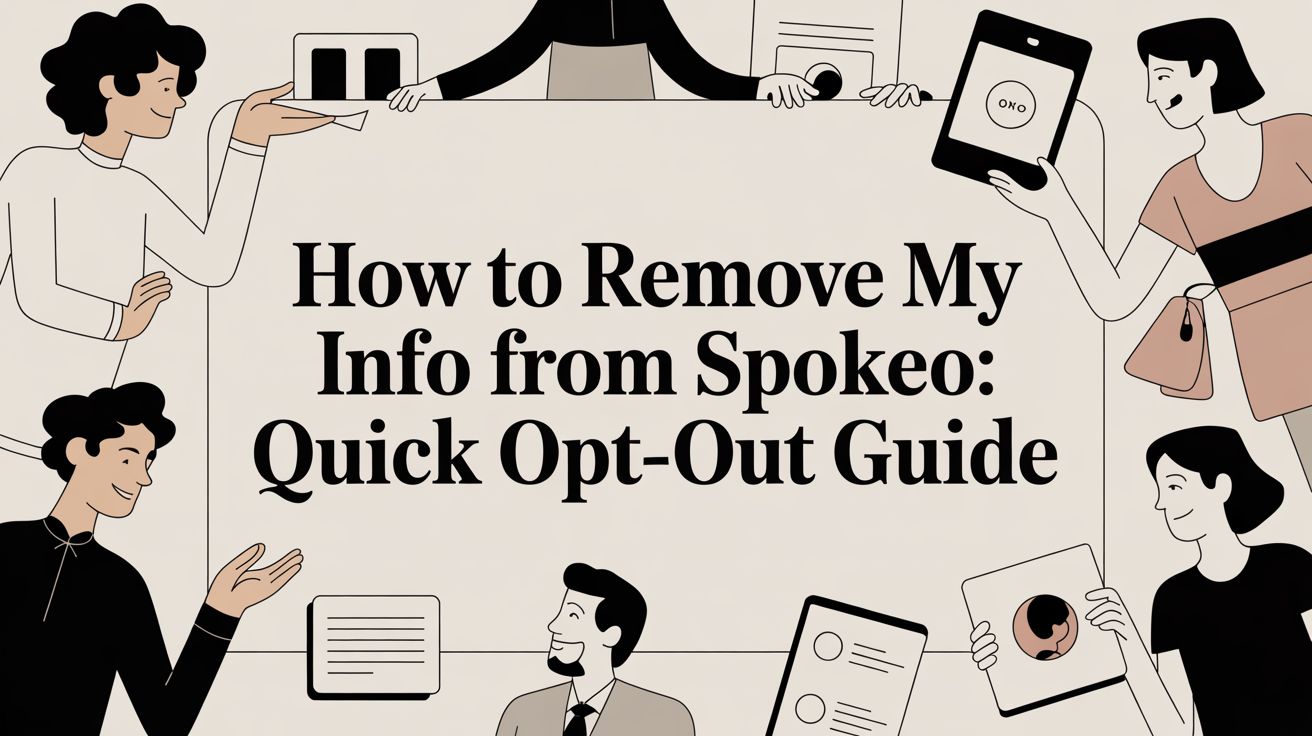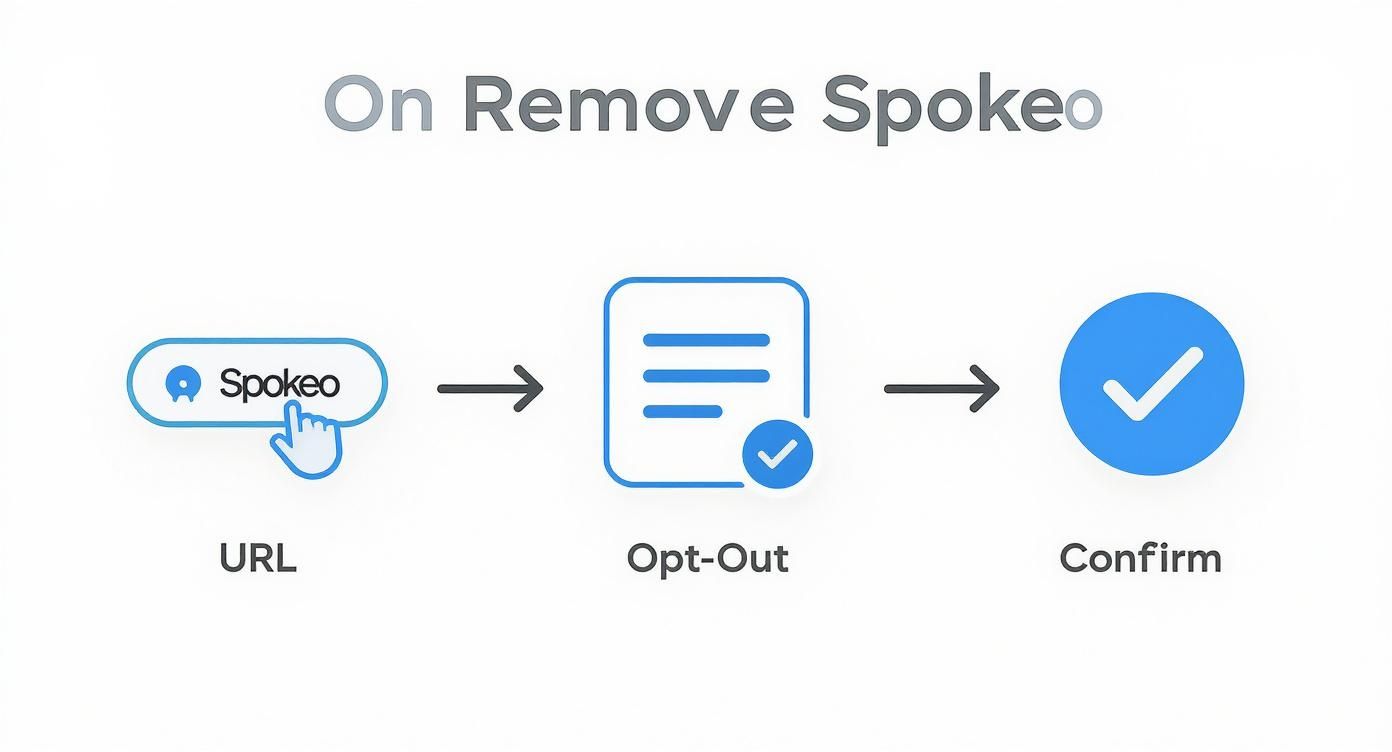
Quick Removal At A Glance
When you need to wipe your Spokeo listing in under 10 minutes, there’s a straightforward path. First, grab the exact URL of your profile. Next, head to Spokeo’s opt-out page, paste that link, complete the reCAPTCHA challenge, and confirm via the email they send you.
You’ll be done before your coffee gets cold—and with no guesswork.
Quick Removal Steps
- Copy your exact Spokeo profile link from the search results.
- Paste it into the opt-out form at Spokeo’s removal page.
- Solve the reCAPTCHA and hit “Submit.”
- Open the confirmation email and click the link.
Common Roadblocks And Fixes
About 30% of DIY attempts stumble on wrong URLs or outdated opt-out forms. If you keep landing on error messages, double-check your link format or clear your browser cache.
Learn more about these removal challenges.
Quick Process Flow Visual

This graphic lays out each step from finding your URL to final confirmation. Follow it closely to eliminate wasted effort.
Removal Effort Versus Success Rate
Below is a comparison of tackling this yourself versus hiring a professional. You’ll see how time investment, success likelihood, and cost stack up.
| Approach | Average Time | Success Rate | Cost |
|---|---|---|---|
| DIY Opt-Out | 10–30 mins | 60–75% | Free |
| Professional Service | 1–3 days | 90–95% | $5–20 |
Whether you’re comfortable handling the steps solo or you’d rather offload to experts, this table helps you choose.
High-Level Success Metrics
Once your form is in:
- You’ll typically see 1–3 matching profiles.
- Spokeo replies within 5–72 hours.
- Removal finalizes in 24–48 hours after you click the confirmation.
Pinpointing your exact listing URL can shave days off processing time and boost success.
Pro Tips To Keep It Smooth
- Keep a running log of each Spokeo URL you submit for easy reference.
- Rename screenshots like
Spokeo_OptOut_MMDDYY.pngto avoid confusion. - Set a calendar alert for 72 hours later to verify removal.
- Use a browser without ad blockers—hidden errors can sneak in under the radar.
With these habits, you’ll dodge most hiccups and keep your opt-out process on track.
This quick-fire overview gives you the essentials for fast data removal. Jump into the next section for a deep dive: identity verification, timing strategies, troubleshooting rejected requests, and when to escalate to a reputation service like LevelField.
Finding What Spokeo Has on You
Before you even think about hitting that opt-out button, you need to do a little detective work. Jumping straight to the removal form without knowing exactly what Spokeo has on you is a classic mistake. It's like trying to weed a garden by only pulling the one you see first—you're guaranteed to miss others that will pop up later. Taking a few minutes to do a thorough audit ensures your removal request is comprehensive and actually works.
Start with the obvious: your full name and current city. But don't stop there. Most of us have a messy data trail scattered across the internet, and Spokeo pulls from 6 billion consumer records to piece it together. You have to think bigger to find it all.
Unearthing Every Version of You
To get a complete picture, you need to search for every possible profile connected to you. It's surprisingly common for people to find multiple, sometimes contradictory, listings they never knew existed.
Be methodical. Your search should cover:
- All Your Names: Think full legal name, common misspellings people make, your maiden name, and any nicknames you've ever gone by.
- Everywhere You've Lived: Don't just check your current address. Search for every city and state you've called home. Spokeo often creates separate profiles from old property records.
- Old Contact Info: Run searches for every phone number and email address you can remember using. A forgotten email from a decade ago can be the anchor for an entire profile.
I once helped someone who found three completely different profiles. The first was under her married name in her current city. The second was linked to her maiden name from a state she hadn't lived in for years. And the third, a real surprise, was built around an old college email address she hadn't touched in over a decade. Each one needed its own separate removal request.
Sifting Through the Noise
As you dig through your listings, you'll see sections like "Possible Relatives" and "Neighbors." Take these with a grain of salt. This information is generated by algorithms and is frequently wrong. Don't get hung up on correcting every inaccurate connection Spokeo thinks you have.
Your goal is to zero in on the core data points that definitively identify your profile: past addresses, phone numbers, and immediate family members you recognize. Ignore the rest.
Data brokers like Spokeo operate in a bit of a gray area. They can legally collect public records, but the process for getting that data removed is often confusing on purpose. As Security.org explains in their data broker research, weak enforcement means many opt-out forms are designed to be difficult. This is exactly why your upfront audit is so critical—a precise, well-documented request is much harder for them to reject.
Key Takeaway: Don't just do one quick search and call it a day. A meticulous audit is the bedrock of a successful removal. Your first real step is to find every single profile URL tied to your identity and save them. This simple act of diligence is what stops your information from reappearing under a different profile just weeks after you thought you were in the clear.
Completing The Spokeo Opt Out Form
Alright, you've got the profile URL. Now for the most critical step: submitting the actual opt-out request. This is where attention to detail really pays off. One wrong character in that URL and Spokeo’s automated system will likely reject your request, sending you right back to square one.
You won't find the form on their homepage. Like most data brokers, Spokeo tucks it away. You can either scroll all the way down to their website footer and find the "Do Not Sell My Info" link, or just go directly to Spokeo.com/optout.
At first glance, the form looks simple. But I've seen countless removal attempts fail because of small mistakes right here.

Breaking Down Each Field
To get this done right the first time, you need to give their system exactly what it's expecting. Let's walk through each field so you can avoid the common hangups.
- Profile URL: This is everything. Paste the full, exact URL you copied from your listing. Double-check for any extra spaces at the beginning or end. Even something as simple as an accidental uppercase letter where a lowercase one should be can trigger an error.
- Email Address: You’ll need an email you can access immediately. Spokeo sends a verification link that you must click to confirm the removal. Many people I've worked with prefer using a secondary or temporary email for this to keep their primary inbox private.
- reCAPTCHA: The final hurdle is the classic "I'm not a robot" check. Just follow the prompt, whether it's a simple checkbox or one of those "click all the traffic lights" puzzles.
After hitting the "Opt Out" button, your job isn't quite done. You have to watch your inbox for that confirmation email.
This step is non-negotiable. If you don't find that email and click the verification link inside, your request will just sit there and eventually get canceled. If it doesn't show up within a few minutes, be sure to check your spam folder.
Insider Tip: I've seen ad blockers cause this form to fail more times than I can count. If you click the "Opt Out" button and nothing happens, try disabling your ad blocker for a moment and submitting it again. It’s a surprisingly common and easy fix.
Why The Small Details Are Everything
Think about it from Spokeo's perspective: they're dealing with a huge number of these requests every single day. Their process is built on automation, which means it has zero tolerance for human error. A clean submission gets processed; a slightly flawed one gets tossed out.
For example, sometimes copying a link from a mobile browser adds weird tracking parameters to the end of the URL. Pasting that will cause an immediate rejection. Always take a second to make sure the URL is clean before you submit. Following these small but crucial steps is the key to ensuring your efforts to remove your info from Spokeo actually work.
Verifying Identity And Monitoring Your Request
Once you hit Opt Out, you’re not quite done. Now comes the verification and waiting phase—a bit like holding a ticket in line instead of seeing an instant delete. Your very next move is to scan your inbox for Spokeo’s confirmation email. Inside, there’s a link you must click to prove you control that address. Miss this step and your request will quietly expire.
What To Expect After Confirmation
After clicking the verification link, Spokeo’s clock starts ticking. They aim to complete removals in 24 to 72 hours, but don’t let that timeline frustrate you.
Here’s a rough schedule:
- Initial 24 Hours: The listing often remains visible. It’s normal—just give the system time.
- 48–72 Hours: Look for a “No Results Found” message. That’s your cue that the page has vanished.
Real-World Insight: Support teams sometimes say a page is down before it actually disappears. If 72 hours slip by and you’re still seeing the profile, it’s time to reach back out.
When Your Request Stalls Or Gets Rejected
Occasionally, your removal will stall or even get denied. Usually, it boils down to one of these issues:
- Expired Verification Link: That link in your email only lives for a short window. If you wait too long, you’ll need to start over.
- Mismatched Information: When an ID check is required, every character of your name must match the profile. Even a missing middle initial can trigger a rejection.
- Unclear Attachments: Blurry or edited ID photos won’t pass muster. Make sure your scan or photo is crisp, complete, and clearly shows your name and address.
If a week goes by with no movement, send a concise, polite follow-up. Here’s an example that’s worked:
Subject: Follow-Up on Opt-Out Request – Case #[Your Case Number]
“Hello Spokeo Support,
I’m checking in on my removal request submitted on [Date] for the profile at [Your Spokeo Profile URL]. I haven’t yet received confirmation of its removal. Could you please update me on the status?
Thank you,
[Your Name]”
That friendly nudge often gets things back on track, helping you finally remove your info from Spokeo without another full resubmission.
What to Do When Spokeo Isn't the Only Problem
Getting your profile off Spokeo is a solid first step, but let's be realistic—it's just one head of the hydra. Spokeo is part of a massive, interconnected web of data brokers who are constantly scraping, buying, and selling information. To actually reclaim your privacy, you have to think bigger than a single opt-out request.
You need a multi-pronged approach. For instance, sometimes these sites go beyond just listing your address. If a website is using your intellectual property without permission, like a photo you took, you have a powerful tool at your disposal: a Digital Millennium Copyright Act (DMCA) takedown notice. This isn't for your average public records listing, but in those specific cases where your copyrighted material is being misused, it's a legal lever that forces the site's host to take the content down.
Looking Beyond Spokeo
A smarter, more strategic move is to go after the source. Data brokers like Spokeo don't generate this information out of thin air; they pull it from larger, "upstream" data aggregators. By finding and removing yourself from these primary sources, you effectively cut off the data supply line. It makes it much harder for your information to reappear on Spokeo or pop up on one of its many competitors.
For example, many smaller people-search sites are powered by the same few data giants. Taking down your profile on a site like FastPeopleSearch can create a domino effect. We've seen it happen time and again, and you can see the exact process in our guide on the FastPeopleSearch opt-out process.
It's more work, no doubt. But this strategy delivers results that actually last. You're not just pulling weeds; you're yanking out the roots.
Manual Removal vs. Automated Services
You absolutely can tackle this yourself. The DIY route involves hunting down dozens of data brokers one by one and navigating each of their unique, and often convoluted, opt-out procedures. Be warned: it's a tedious, frustrating grind. Even after all that work, your data can pop right back up a few months later when they refresh their databases.
This is where automated services have become a game-changer. These platforms do the heavy lifting for you, firing off hundreds of removal requests and then continuously scanning to make sure your data stays gone. The difference in results is stark. We typically see professional data broker removal services achieve 90–95% success rates. Manual efforts? They often top out around 60–70%. Plus, an automated service can blast out hundreds of requests in under a week.
DIY Versus Professional Removal Comparison
Deciding between the manual grind and a professional service comes down to how you value your time, money, and the final outcome. Here’s a quick breakdown of what to expect from each path.
| Metric | Manual Opt-Out | Automated Service |
|---|---|---|
| Cost | Free (monetarily) | Monthly or annual subscription fee |
| Time Investment | High (dozens of hours initially, plus ongoing monitoring) | Low (minimal setup time) |
| Success Rate | Lower (typically 60–70%) due to complexity and reappearances | High (typically 90–95%) with continuous monitoring |
| Effort | Demanding and repetitive; requires organization and persistence | Set it and forget it; the service handles everything |
Ultimately, while the DIY approach costs you nothing but time, the lower success rate and constant need for vigilance make professional services a compelling option for anyone serious about protecting their digital footprint.
Key Takeaway: To remove your info from Spokeo for good, you need a comprehensive plan. It means targeting the upstream data sources, using legal tools like DMCA notices where they apply, and making a crucial decision: either commit to the persistent, manual effort of DIY removals or invest in a more effective automated solution.
Preventing Reappearances And Ongoing Monitoring

Getting your profile off Spokeo feels like a victory, but it's often a temporary one. These data brokers are constantly scraping public records and other online sources, which means your information can pop right back up in as little as three to six months. Suddenly, you're right back where you started.
That’s why your work isn’t done once the listing is gone. The real long-term strategy shifts from one-time removal to ongoing monitoring and prevention.
Setting Up Your Defense System
The good news is that you don't have to spend hours every week scouring the web. With a few simple tools and habits, you can build a solid defense system to keep your data off these sites for good.
Here’s how you can stay on top of it:
- Set Up Google Alerts: This is your early-warning system, and it’s completely free. Create an alert for your full name in quotes (like "Jane Smith") and another for your name plus your city ("Jane Smith" Chicago). Google will shoot you an email any time it finds a new page mentioning you, giving you a heads-up if a new Spokeo profile appears.
- Schedule Manual Checks: Don’t rely on automation alone. I always tell clients to set a calendar reminder to manually search for their name on Spokeo every six months. It only takes a few minutes and is the best way to catch anything that slips through the cracks.
For a deeper dive, it’s worth exploring comprehensive strategies to stay anonymous online. True privacy isn't just about removing old data; it's about minimizing the digital footprint you create moving forward.
Pro Tip: When your data reappears, it's rarely Spokeo itself finding it. More often, they've just bought an updated list from a larger, upstream data aggregator. Targeting these primary sources can be a far more effective way to stop your profile from being repopulated across multiple sites.
Sometimes, the problem is just too big to handle on your own. If you're fighting listings on multiple sites or your information just keeps coming back, it might be time to bring in the professionals. Learning how to remove negative search results can be a game-changer, and a reputation management firm like LevelField has the resources to tackle the persistent, multi-platform removals needed for lasting privacy.
Common Questions About Removing Your Info From Spokeo
Even a straightforward process like Spokeo's opt-out can hit a snag. Let's walk through a few of the most common questions that pop up, especially when things don't go perfectly on the first try. Knowing the answers ahead of time will help you troubleshoot any issues without losing momentum.
How Long Does Spokeo Take to Process a Removal Request?
Spokeo is usually pretty quick. You can typically expect your removal request to be processed within 5 to 10 business days.
If two full weeks have gone by and you haven't seen a confirmation email or noticed your profile is gone, it's time to follow up. Just send a polite note to their support team with your original submission date and the profile URL to help them track it down faster.
Why Did Spokeo Reject My Opt-Out Form?
Rejections are almost always due to a small, easily fixable mistake. I've seen it happen time and again, and it usually boils down to one of these three things:
- URL Formatting Errors: This is the big one. Copying the profile link with an extra space or a missing character is the number one reason requests get kicked back.
- Mismatched Names: The name you enter on the form has to be an exact match to the one on the Spokeo profile. A missing middle initial or a slight misspelling is enough to cause a rejection.
- Missing ID Verification: If Spokeo asks for proof of identity to confirm you are who you say you are, you have to provide it. If you don't, the request will just sit there until it's eventually denied.
It's also helpful to have some context on how data brokers gather information in the first place, including the details surrounding the legality of web scraping. Understanding this makes it clear why they are so meticulous about matching every detail in a removal request.
Key Takeaway: If your request gets rejected, don't panic or start over from scratch. The first thing you should do is check for a simple error, like a typo in the URL or a name mismatch. Resubmit the form with the corrected information—that simple double-check will solve the problem 99% of the time.
